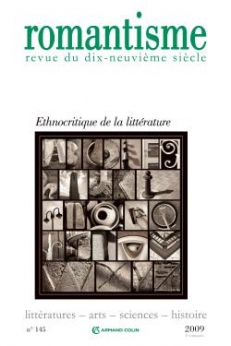
Romantisme n° 145 (3/2009)
Pour acheter ce numéro, contactez-nous
Recevez les numéros de l'année en cours et accédez à l'intégralité des articles en ligne.
Notre hypothèse de travail est qu’il y a une homologie structurelle et fonctionnelle entre le rite de passage (Van Gennep) et le récit littéraire. La trajectoire narrative des personnages serait donc l’histoire d’une mise en marge, qui aurait pour objectif de les faire accéder à un nouveau statut. Mais certains d’entre eux se caractérisent précisément par leur incapacité à quitter l’entre-deux de la phase de marge : nous proposons de leur réserver l’étiquette de « personnage liminaire ». Le personnage liminaire est donc toujours un non ou un mal « initié » (à condition de donner à l’« initiation » une acception strictement anthropologique). Ainsi, la Teuse, la servante boiteuse et sonneuse de cloches de La Faute de l’abbé Mouret, est bien avant tout un personnage de (vieille) fille qui n’est pas «passée». La fonction première de ce type de personnage est sans doute d’être un personnage-témoin, placé simplement au degré ultime de l’échelle du ratage initiatique qu’empruntent tous les personnages du roman moderne. Mais l’initiation impossible lui confère aussi une ambivalence constitutive qui peut faire de lui un passeur pour les autres. Le moins initié devient alors un sur-initié ; dans certains cas même, le personnage liminaire a tout du trickster.
This article postulates the existence of a structural and functional homology between rite (especially Van Gennep’s rite of passage) and narrative. The narrative trajectory of literary characters can thus be envisaged as the story of a marginalisation, meant to endow them with a new status. Some of them are marked by their incapacity to leave the “in-betweenness” of marginality. It is such characters we choose to call “liminary characters”. The liminary character is therefore always incomplete, in the sense that he/she remains “un-” or “ill-initiated” (the term “initiation” must be given a strictly anthropological meaning). Thus “la Teuse”, the lame servant and bell-ringer in La Faute de l’abbé Mouret, is essentially an old maid who has not “got over the threshold”. The primary function of that type of character is to be a witness, positioned at the highest rung of the “scale of initiatory failure” most characters from modern novels more or less follow. But this impossible initiation also gives the character a constitutive ambivalence that can turn him/her into an initiator for others. The “leastinitiated” therefore becomes a “super-initiated” ; in some cases, the liminary character can even become a trickster.

